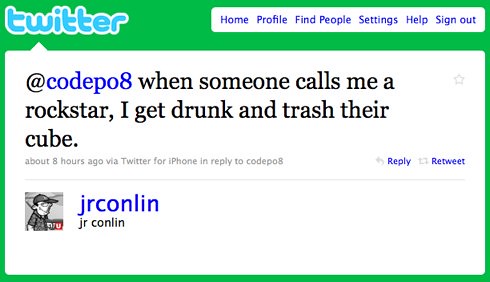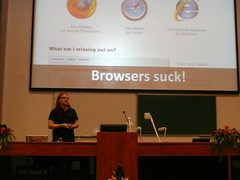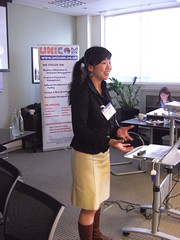Can we stop with the Ninja and Rockstar hype already?
Friday, August 13th, 2010I get very tired of people looking for rockstar and ninja developers. I find it arrogant and actually detrimental to the whole market of development. We are professionals and we should take our jobs serious. We should also make sure that people who start in a company don’t have to deal with a terrible mess rather than being able to contribute immediately.
During my whole career I concentrated not on bringing myself into the centre and be the rockstar of a department but instead try damn hard to build sustainable teams and departments. This might have been a wrong decision in terms of money but seeing people grow and processes improve gives me a bigger kick than being admired as the guy who knows it all. There is a lot of quick glory in being a “Ninja” or a “Rockstar” but it is actually bad for the company. It is also a problem for your own career as you make people dependent on you rather than being able to grow and change to what you want to be and do in the future.
One of the big mistakes I was part of in the past was that I was part of a team of rockstars. When I joined the company the mandate was to get the best people in front end development and build the coolest products. I was proud as punch to be able to hire people I had a boatload of respect for and always wanted to work with. We all had the best ideas, we had the talent and we were hungry to prove ourselves.
What we didn’t have was the insight into how to make a large company care as much about what we do as we did. What we also didn’t have is the patience to understand that people who don’t want to immediately support you don’t do that out of spite but because they have other things to worry about. A big part of work is politics and that means that things don’t move as quickly as engineers want to. This is a human issue – take too many people to make a decision and it will take longer. On the other hand this decision can become a much better one as it has been scrutinised from several angles. Sadly enough in most cases when it comes to decisions made across departments of companies they don’t turn out better. The reason is that people don’t talk to another but follow their individual agendas instead. A lot of companies made process the goal and not the way towards the goal.
I am right now preparing my talk for this year’s Paris Web and it will revolve around the issue of getting listened to in the company and the market if you are a technical person. We can delude ourselves into thinking that building great products will get us fame and insight and be listened to but in the end it will be the product managers who’ll be remembered being the people who brought these products to life and not the people who built them.
The rockstar analogy
I think my ex-colleague JR Conlin hit the nail on the head:
Being a real rockstar gets you the fame, the sex and the drugs. However it also robs you of your privacy, forces you to repeat over and over again what you’ve done in the past and it typecasts you:
It also means that unless you are clever and you start your own label or production company or do your own merchandise a lot of people will make a lot of money on top of your talent and you only get a small share of that.
Rockstar fame is very fleeting – people who are on top now can be amazingly quickly forgotten tomorrow. Popularity is quite a tough thing to keep up and any slip-up you have will be all over the news and misinterpreted to become headlines. At first this aids your bad boy image but later on when you get older it just appears pathetic.
In essence being a rockstar means burning out quickly with a lot of glory but not much sustenance. And if you don’t plan cleverly for your future you’ll end up playing carnivals and open up shopping malls. I have a hard time to find the equivalent for an IT rock star.
For a company it means you have a employee that is hard to work with and that you need to keep happy all the time. A diva that is very much aware of his or her temporary fame and makes ridiculous demands (check the rider of some rock bands or talk to some roadies or people who work in theatres for tales of woe). You also concentrate on a single person and thus cause jealousy in the rest of your staff which means that they either under-perform, try to sabotage the rockstar or leave.
It also means that you have to sort out the troubles your rockstar gets into. Unmaintainable products that have the handwriting of one genius developer and no documentation on them are the IT equivalent of trashed hotel rooms. Headhunters calling your rockstar are the equivalent of the paparazzi. The only thing that is less likely to happen is getting into troubles with groupies.
In essence I see the demand of rockstars as a flattering way of companies to find somebody to quickly burn out and get a quick product out of that can be hyped. Nothing sustainable and especially nothing that hints that there will be a chance of a career for you in that environment. You start at the top of your game and you are expected to over-perform. Any request to get official support to improve will be seen as a weakness.
The Ninja analogy
People calling themselves $technology-ninja has only recently become popular. John Resig was one of the first with the JavaScript Ninja mailing list (which has become very silent as of late) and Nicole Sullivan had an interview published that started with the notion of her calling herself a Ninja.
You know what? I forgive both of them this – both John and Nicole consistently worked in silence and out of a sudden released a deadly cool technique or product before they went off again to hone their skills on the next attack. They never celebrated themselves much but instead promoted technologies to use in a professional environment and to get quick results. I am friends with them and I admire them for what they did and what they are about to do. I am confident they have more and more cool things up their sleeves in the future.
Lately, however, the Ninja analogy runs rampant with 4606 of them being available on LinkedIn:
A lot of the self proclaimed Ninja know their trade but it is actually interesting to see what they have forgotten when it comes to being a Ninja:
- Ninja attack silently and use the element of surprise
- Ninja disguise themselves to blend in
- Ninja are not seen or heard
- Ninja use a series of passwords and own languages to talk to another to be more effective
As a company, hiring a Ninja only makes sense if you want to disrupt your competition as the main tasks of Ninja are:
- Espionage – do you want to get rid of your secrets?
- Sabotage – hire a rockstar instead, he’ll make sure your products will decay quickly
- Assassination – not that applicable either.
When it comes to the JavaScript Ninja mailing list this made sense – a closed community with an own language that shares secrets with another and leaks them to the outside world to sabotage bad products and assassinate bad practices. And most people on it are rarely seen or heard (Dean Edwards and Stuart Langridge anyone?).
When it comes to people who call themselves a $technology-ninja the metaphor quickly crumbles to the same levels of “I am a social media expert” or “SEO wizard”.
Look for Sensei, Mercenaries and Padawan instead
If you really want to use an analogy (I don’t think we need to but hey, they sell like hotcakes) then I’d think you should focus on people who really will help your company:
- Mercenaries – in the middle ages we had mercenaries who roamed the land offering their strength and skill with their weapon to anyone who could afford them. They also were masters of marketing and changed their names to impressive things like Schwerdtfeger (“The one who sweeps with his sword”). A mercenary is a single minded person doing the job without any regrets, values or beliefs. They get the job done and move on. There is no loyalty beyond the contract and there are no demands beyond what was agreed on. They are independent and bring all the tools they need and are not interested in sharing. If you want to build a product to make some noise and you don’t expect it to be scalable or stay the way it is anyway then these are the people you want. Mercenaries are rockstars with their own label. Or think of Jayne Cobb in Firefly
- Sensei – are teachers, as simply as that. People who know their skills and know how to teach them to others. It ails me that in IT trainers are not paid as high as engineers. Being able to build something is one thing – being able to guide others to build the same so they don’t need you or your input in the future is a much less common skill. A good Sensei knows when to guide, when to explain, when to show and when to allow his students to fail and hurt themselves. It is strange but we learn more from making mistakes and avoiding them in the future than from doing things right. This should apply to companies, too. Lately when Google put Wave on the back burner a lot of people started writing sarcastic posts about it – just to learn after some research that there is no problem in failing when you analyse and salvage what was useful. A good Sensei is a developer with experience who knows what to keep away from his students and when to let them run free and show their skills. A good teacher makes himself not needed over time – for his students to become masters and then teachers themselves. Lead by example but leave space in your solutions for the creativity of your students and you will build working products that are ready for future improvements.
- Padawan – are young talents that show a massive proficiency in a certain subject matter (in the case of the Star Wars movies the force and being able to not scream every time some guy calls them “Annie”). They don’t need to be amazing at it but they should show adaptability, a hunger to improve and be open and ready to listen to advice – even if it seems not fascinating and shiny at that time. These are developers who want to build things – to create systems as a team and partner with people who are passionate about the other skills necessary to achieve the goal. They also should question authority and find their own way but be driven by achieving peace with their environment rather than disrupting it for the sake of disrupting it. They are developers that you can coach, mentor and form and partner with other skilled people to rely on another and share with another. They are also developers that when they get bored with what they do should get the chance to switch departments, roles and train them up to become leaders and Sensei
What do you think? Is it worth to let vanity and arrogance run our markets and frustrate people who want to learn rather than shine or should we concentrate on building an empowered work force rather than a privileged few?





 First up is an inspiration of mine,
First up is an inspiration of mine, 

 I have worked with Meltem in my previous company, Netdecisions (now Agilisys) and seen her move from being a web developer to becoming a manager/architect in a short period of time. She is amazingly fast at taking up new technologies and ideas and validating them before coming up with a great new way of looking at them. What impresses me most about Meltem is that she is a fighter. When one of her absolutely adoring daughters died of cancer she took on the challenge and started a charity that tries to help parents in the same situation and raise awareness of how this special kind of cancer can be battled. You can find all the information about this charity and her sterling work in this area at
I have worked with Meltem in my previous company, Netdecisions (now Agilisys) and seen her move from being a web developer to becoming a manager/architect in a short period of time. She is amazingly fast at taking up new technologies and ideas and validating them before coming up with a great new way of looking at them. What impresses me most about Meltem is that she is a fighter. When one of her absolutely adoring daughters died of cancer she took on the challenge and started a charity that tries to help parents in the same situation and raise awareness of how this special kind of cancer can be battled. You can find all the information about this charity and her sterling work in this area at 



 From the first moment I met
From the first moment I met 


